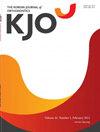Bracket bonding to polymethylmethacrylate-based materials for computer-aided design/manufacture of temporary restorations: Influence of mechanical treatment and chemical treatment with universal adhesives
IF 1.9
3区 医学
Q1 Dentistry
引用次数: 5
Abstract
Objective To assess shear bond strength and failure mode (Adhesive Remnant Index, ARI) of orthodontic brackets bonded to polymethylmethacrylate (PMMA) blocks for computer-aided design/manufacture (CAD/CAM) fabrication of temporary restorations, following substrate chemical or mechanical treatment. Methods Two types of PMMA blocks were tested: CAD-Temp® (VITA) and Telio® CAD (Ivoclar-Vivadent). The substrate was roughened with 320-grit sandpaper, simulating a fine-grit diamond bur. Two universal adhesives, Scotchbond Universal Adhesive (SU) and Assure Plus (AP), and a conventional adhesive, Transbond XT Primer (XTP; control), were used in combination with Transbond XT Paste to bond the brackets. Six experimental groups were formed: (1) CADTemp®/SU; (2) CAD-Temp®/AP; (3) CAD-Temp®/XTP; (4) Telio® CAD/SU; (5) Telio® CAD/AP; (6) Telio® CAD/XTP. Shear bond strength and ARI were assessed. On 1 extra block for each PMMA-based material surfaces were roughened with 180-grit sandpaper, simulating a normal/medium-grit (100 mm) diamond bur, and brackets were bonded. Shear bond strengths and ARI scores were compared with those of groups 3, 6. Results On CAD-Temp® significantly higher bracket bond strengths than on Telio® CAD were recorded. With XTP significantly lower levels of adhesion were reached than using SU or AP. Roughening with a coarser bur resulted in a significant increase in adhesion. Conclusions Bracket bonding to CAD/CAM PMMA can be promoted by grinding the substrate with a normal/medium-grit bur or by coating the intact surface with universal adhesives. With appropriate pretreatments, bracket adhesion to CAD/CAM PMMA temporary restorations can be enhanced to clinically satisfactory levels.计算机辅助设计/制造临时修复用聚甲基丙烯酸甲酯基材料的支架粘接:通用胶粘剂机械处理和化学处理的影响
目的评价计算机辅助设计/制造(CAD/CAM)临时修复体在基材化学或机械处理后,与聚甲基丙烯酸甲酯(PMMA)块结合的正畸托槽的剪切强度和破坏模式(粘接残余指数,ARI)。方法对CAD- temp®(VITA)和Telio®CAD (Ivoclar-Vivadent)两种PMMA块进行检测。基材用320粒砂纸进行粗化,模拟细粒金刚石bur。两种通用粘合剂,Scotchbond通用粘合剂(SU)和Assure Plus (AP),以及一种传统粘合剂Transbond XT Primer (XTP;对照),与Transbond XT Paste结合使用以粘合括号。分为6个实验组:(1)CADTemp®/SU;(2) CAD-Temp®/美联社;(3) CAD-Temp®/ XTP;4) Telio®CAD/SU;5 . Telio®CAD/AP;(6) Telio®CAD/XTP。评估剪切粘结强度和ARI。在每个pmma基材料的额外一块上,用180粒度的砂纸对表面进行粗糙处理,模拟普通/中等粒度(100毫米)的金刚石bur,并粘合支架。比较3、6组的剪切键强度和ARI评分。结果CAD- temp®的支架结合强度明显高于Telio®CAD。与使用SU或AP相比,XTP的附着力明显降低。使用较粗的粗钢进行粗化导致附着力显著增加。结论用普通/中砂磨基材或在完整表面涂上通用胶粘剂可促进支架与CAD/CAM PMMA的结合。通过适当的预处理,支架与CAD/CAM PMMA临时修复体的粘连可以提高到临床满意的水平。
本文章由计算机程序翻译,如有差异,请以英文原文为准。
求助全文
约1分钟内获得全文
求助全文
来源期刊

Korean Journal of Orthodontics
Dentistry-Orthodontics
CiteScore
2.60
自引率
10.50%
发文量
48
审稿时长
3 months
期刊介绍:
The Korean Journal of Orthodontics (KJO) is an international, open access, peer reviewed journal published in January, March, May, July, September, and November each year. It was first launched in 1970 and, as the official scientific publication of Korean Association of Orthodontists, KJO aims to publish high quality clinical and scientific original research papers in all areas related to orthodontics and dentofacial orthopedics. Specifically, its interest focuses on evidence-based investigations of contemporary diagnostic procedures and treatment techniques, expanding to significant clinical reports of diverse treatment approaches.
The scope of KJO covers all areas of orthodontics and dentofacial orthopedics including successful diagnostic procedures and treatment planning, growth and development of the face and its clinical implications, appliance designs, biomechanics, TMJ disorders and adult treatment. Specifically, its latest interest focuses on skeletal anchorage devices, orthodontic appliance and biomaterials, 3 dimensional imaging techniques utilized for dentofacial diagnosis and treatment planning, and orthognathic surgery to correct skeletal disharmony in association of orthodontic treatment.
 求助内容:
求助内容: 应助结果提醒方式:
应助结果提醒方式:


